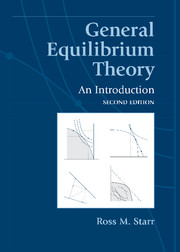Book contents
- Frontmatter
- Contents
- List of illustrations
- Introduction to the second edition
- Preface to the second edition
- Preface to the first edition
- Table of notation
- Table of assumptions
- A General equilibrium theory: Getting acquainted
- B Mathematics
- C An economy with bounded production technology and supply and demand functions
- D An economy with unbounded production technology and supply and demand functions
- E Welfare economics and the scope of markets
- F Bargaining and equilibrium: The core
- G An economy with supply and demand correspondences
- H Standing on the shoulders of giants
- Bibliography
- Index
G - An economy with supply and demand correspondences
Published online by Cambridge University Press: 05 June 2012
- Frontmatter
- Contents
- List of illustrations
- Introduction to the second edition
- Preface to the second edition
- Preface to the first edition
- Table of notation
- Table of assumptions
- A General equilibrium theory: Getting acquainted
- B Mathematics
- C An economy with bounded production technology and supply and demand functions
- D An economy with unbounded production technology and supply and demand functions
- E Welfare economics and the scope of markets
- F Bargaining and equilibrium: The core
- G An economy with supply and demand correspondences
- H Standing on the shoulders of giants
- Bibliography
- Index
Summary
In Chapters 10–18, we developed the theory of firm and household behavior, concentrating on the case of strictly convex preferences and strictly convex production technology sets. Using strict convexity allowed us to use point-valued supply and demand functions. There are many settings, however, where this mathematically simple formulation seems inappropriate economically; for example, when there are perfect substitutes in consumption or when production technologies are linear. In these cases, where weak rather than strict convexity holds, supply and demand relations appear to be set valued. Figure G.1 presents the example of a firm with a linear production technology and the resulting set-valued supply function. Figure G.2 shows the case of a consumer choosing between perfect substitutes with the resulting set-valued demand behavior. It is important in these examples that preferences and technology be convex, even though they are not strictly convex. That assures us that a household demand or a firm supply at given prices can be characterized as a convex set. Figure G.3 depicts, in partial equilibrium, typical resulting supply and demand curves and possible market equilibria.
We need a mathematical treatment that will allow us to deal with this additional complexity. Fortunately, there is an available theory of continuous point-to-set mappings that fully parallels the theory of continuous functions. We will develop concepts of continuity and a fixed-point theorem that will allow us to duplicate, in the more general setting of set-valued supply and demand, the results on existence of equilibrium we developed for point-valued supply and demand in Chapters 11–18.
- Type
- Chapter
- Information
- General Equilibrium TheoryAn Introduction, pp. 275 - 278Publisher: Cambridge University PressPrint publication year: 2011



